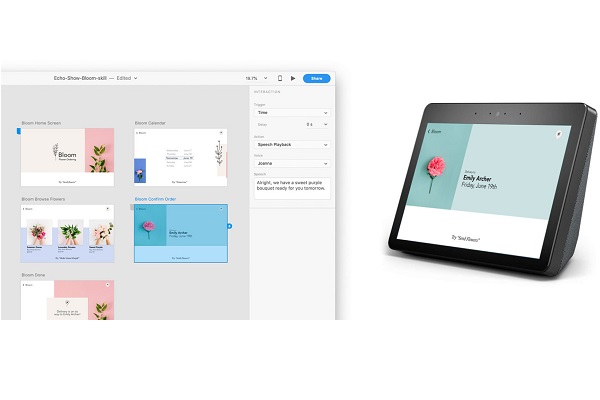Adobe’s Head of Voice on Alexa Skills, Designers, and a ‘Controversial’ Decision

Adobe launched its first Alexa skill last week. The Adobe XD skill and related plugin connect the voice assistant to Adobe’s platform but are just part of the company’s larger strategy for voice technology. Voicebot spoke with Mark Webster, the head of voice at Adobe, about some of the more controversial facets of the new member of Adobe’s product stable, and how he envisions a designer-focused future of voice tech.
Alexa Enhancement
The Alexa Adobe XD skill and plugin act as an extension of the popular design tool for developers. It enables users to prototype new ideas and products for Alexa using Adobe tools. As the landscape of Alexa skills grows, Webster said this is the perfect moment for Adobe to enter the scene.
“There are a lot of Alexa skills, but a lot of them could be better,” Webster said. “Designers haven’t been part of their creation, but there’s a need for experienced designers to be involved.”
The point is to remove the need for developers to be involved at the prototyping stage, he explained. This way, the designers can show how they envision the Alexa skill before committing the time and resources of the larger team.
Designer Design
 What makes the Adobe XD process truly different is that shift to designer focus, Webster said. Designers tend to hand off the product to developers earlier for voice apps, compared to mobile apps. But, because the plugin allows for less technical prototyping, designers can be more deeply involved beforehand.
What makes the Adobe XD process truly different is that shift to designer focus, Webster said. Designers tend to hand off the product to developers earlier for voice apps, compared to mobile apps. But, because the plugin allows for less technical prototyping, designers can be more deeply involved beforehand.
“The right workflow for XD would be to really focus on storytelling, and only at the point you’re going to build actual intents do you then pass it off [to developers],” Webster said. “We’re trying to start with where we think design is going to go. The experience is better on platforms when designers are empowered to create. The idea was how do you start from scratch, how to make it design-driven. We are giving designers access to the medium of voice.”
No Apologies
Webster did highlight one way the new plugin shifts prototyping in a way he described as potentially controversial. Alexa won’t apologize and say it doesn’t understand you if you say the wrong command.
“We don’t support fallback intents. If Alexa doesn’t understand what you said, it loops back and opens up the mic again,” Webster said. “The XD prototype [turns on the] mic light again with no chime. It’s very different from how a lot of stuff works. We were thinking about the designer use case when pitching to a client. This way, you still repeat yourself, but in context, it’s better than sitting through error messages.” Alexa skills can still have fallback intents added when they go into development. However, Adobe is optimizing for the prototyping and demonstration use cases where fallback intents are not needed for the user experience and can work counter to the intended objective.
More Voices
Amazon won’t be the only company with an Adobe XD plugin for long. Webster said there are already plans in the works to add the other major voice platforms to the list, though he couldn’t be specific about the timeline. Alexa was the first simply because of what the company was hearing from XD users.
“The power of Adobe is that it’s platform agnostic. We want to empower all of the creative community, but we had to pick a starting point,” Webster said. “We started with Amazon because we heard more from designers about their need for [Adobe XD] to be on Alexa. A lot of the tech we’ve already used could be connected to different platforms. Let’s say 80 percent of the work is done.”
It may not be solely Adobe behind the effort either. According to Webster, any third party could build on XD, whether it’s the Google Assistant team or another company working for them. That aspect of the process isn’t one that he and Adobe are interested in.
“Adobe’s power is to stay open, and focus on the creative piece of the process,” Webster said. “Our effort for the last year, beyond voice, has been make XD a platform.”
As Adobe works to add new voice platforms, Webster said the goal is to get voice tech into as many areas of life as possible. That includes both consumer and enterprise focuses, as he sees them as not different when it comes to creating new apps.
“To me, voice is the story of additional interaction,” Webster said. “I want to push the world of experience design into the future.”
Follow @voicebotai Follow @erichschwartz








